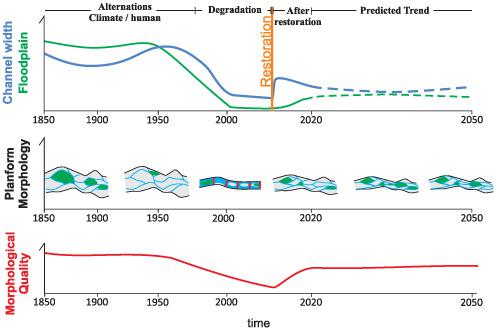当前位置:
X-MOL 学术
›
Earth Surf.Process. Land.
›
论文详情
Our official English website, www.x-mol.net, welcomes your feedback! (Note: you will need to create a separate account there.)
Restoring a glacier‐fed river: Past and present morphodynamics of a degraded channel in the Italian Alps
Earth Surface Processes and Landforms ( IF 3.3 ) Pub Date : 2020-06-18 , DOI: 10.1002/esp.4931 Vittoria Scorpio 1, 2 , Andrea Andreoli 1 , Mattia Zaramella 3 , Sara Moritsch 4 , Joshua Theule 5 , Andrea Dell'Agnese 1 , Susanne Muhar 4 , Marco Borga 3 , Walter Bertoldi 6 , Francesco Comiti 1
Earth Surface Processes and Landforms ( IF 3.3 ) Pub Date : 2020-06-18 , DOI: 10.1002/esp.4931 Vittoria Scorpio 1, 2 , Andrea Andreoli 1 , Mattia Zaramella 3 , Sara Moritsch 4 , Joshua Theule 5 , Andrea Dell'Agnese 1 , Susanne Muhar 4 , Marco Borga 3 , Walter Bertoldi 6 , Francesco Comiti 1
Affiliation

|
The present study explores the evolutionary trajectory of the glacier‐fed Mareit River (South Tyrol, Italian Alps), where a large restoration programme was implemented in 2008–2009. River corridor changes before and after the restoration works were assessed using historical maps, recent field observations, topographic surveys and topographic differencing. Trends of anthropic (forest cover, channel works, gravel mining) and natural (glacial cover, precipitation, flow regime) factors controlling channel morphology – at both catchment and reach scales – were reconstructed. From the mid‐19th century, the evolutionary trajectory of the Mareit River followed a degradational trend, characterized by channel narrowing, bed incision and planform simplification. Direct, in‐channel human alterations – mainly in the form of bank protections (in the late 19th century), gravel mining (mostly in the 1970s) and grade‐control works (since the 1980s) – dominated the historical adjustments before the restoration. In 2008–2009, a segment of the Mareit was restored by widening the channel, partly removing the check‐dams and shaping a braided pattern within a laterally constrained corridor. Post‐work monitoring shows that the restoration improved both the morphological quality and the geomorphic diversity. At present, the channel is subject to narrowing and slight bed level incision, with islands and floodplains progressively expanding at the expenses of the active channel. This trend is likely to continue in the next decades based on the expected future flow regime, and indeed the Mareit River seems to be attaining a ‘miniaturized’ version of the anabranching pattern of the mid‐19th century. Overall, this restoration approach and the associated evolutionary trajectory is considered positive, because it leads to a complex mosaic of geomorphic units, dynamically self‐adjusting to the time‐varying driving variables. The formation of a morphodynamically active corridor, while keeping artificially non‐erodible boundaries, represents an optimal strategy to integrate ecological improvements with flood risk mitigation in the densely populated Alpine valleys. © 2020 John Wiley & Sons, Ltd.
中文翻译:

恢复冰川河:过去和现在意大利阿尔卑斯山退化河道的形态动力学
本研究探讨了由冰川喂养的马雷特河(南阿尔卑斯山,意大利阿尔卑斯山)的演化轨迹,该冰川在2008–2009年实施了大规模的恢复计划。使用历史地图,近期实地观察,地形调查和地形差异评估了修复工程前后的河道变化。重建了人类活动(森林覆盖,河道工程,砾石开采)和自然(冰川覆盖,降水,水流状态)因素的趋势,这些趋势控制着流域和覆盖范围的河道形态。从19世纪中叶开始,Mareit河的演变轨迹呈退化趋势,其特征是河道变窄,河床切口并简化了平台。直接,河道内人为改变(主要是银行保护(在19世纪末),砾石开采(主要在1970年代)和坡度控制工作(自1980年代))在恢复之前的历史调整中占主导地位。2008-2009年,通过拓宽河道,部分拆除止水坝并在侧向受约束的走廊内形成编织图案,恢复了马雷特河的一部分。事后监测表明,恢复工作改善了形态质量和地貌多样性。目前,该航道正受到狭窄和轻微的水平面切口的影响,岛屿和洪泛区逐渐扩大,但要消耗活动航道。根据预期的未来流量机制,这种趋势可能会在未来几十年内持续下去,实际上,马里特河(Mareit River)似乎正在实现19世纪中叶扩张模式的“微型化”版本。总的来说,这种恢复方法和相关的进化轨迹被认为是积极的,因为它导致了复杂的地貌单元镶嵌图,可以随时间变化的驱动变量进行动态自我调整。形态动力学活跃的走廊的形成,同时又保留了人为不易侵蚀的边界,是在人口稠密的高山山谷中整合生态改善与减轻洪水风险的最佳策略。分级为4 +©2020 John Wiley&Sons,Ltd. 动态地根据时变行驶变量进行自我调整。形态动力学活跃的走廊的形成,同时保留了人为不易侵蚀的边界,是在人口稠密的高山山谷中整合生态改善与减轻洪水风险的最佳策略。分级为4 +©2020 John Wiley&Sons,Ltd. 动态地根据时变行驶变量进行自我调整。形态动力学活跃的走廊的形成,同时又保留了人为不易侵蚀的边界,是在人口稠密的高山山谷中整合生态改善与减轻洪水风险的最佳策略。分级为4 +©2020 John Wiley&Sons,Ltd.
更新日期:2020-06-18
中文翻译:

恢复冰川河:过去和现在意大利阿尔卑斯山退化河道的形态动力学
本研究探讨了由冰川喂养的马雷特河(南阿尔卑斯山,意大利阿尔卑斯山)的演化轨迹,该冰川在2008–2009年实施了大规模的恢复计划。使用历史地图,近期实地观察,地形调查和地形差异评估了修复工程前后的河道变化。重建了人类活动(森林覆盖,河道工程,砾石开采)和自然(冰川覆盖,降水,水流状态)因素的趋势,这些趋势控制着流域和覆盖范围的河道形态。从19世纪中叶开始,Mareit河的演变轨迹呈退化趋势,其特征是河道变窄,河床切口并简化了平台。直接,河道内人为改变(主要是银行保护(在19世纪末),砾石开采(主要在1970年代)和坡度控制工作(自1980年代))在恢复之前的历史调整中占主导地位。2008-2009年,通过拓宽河道,部分拆除止水坝并在侧向受约束的走廊内形成编织图案,恢复了马雷特河的一部分。事后监测表明,恢复工作改善了形态质量和地貌多样性。目前,该航道正受到狭窄和轻微的水平面切口的影响,岛屿和洪泛区逐渐扩大,但要消耗活动航道。根据预期的未来流量机制,这种趋势可能会在未来几十年内持续下去,实际上,马里特河(Mareit River)似乎正在实现19世纪中叶扩张模式的“微型化”版本。总的来说,这种恢复方法和相关的进化轨迹被认为是积极的,因为它导致了复杂的地貌单元镶嵌图,可以随时间变化的驱动变量进行动态自我调整。形态动力学活跃的走廊的形成,同时又保留了人为不易侵蚀的边界,是在人口稠密的高山山谷中整合生态改善与减轻洪水风险的最佳策略。分级为4 +©2020 John Wiley&Sons,Ltd. 动态地根据时变行驶变量进行自我调整。形态动力学活跃的走廊的形成,同时保留了人为不易侵蚀的边界,是在人口稠密的高山山谷中整合生态改善与减轻洪水风险的最佳策略。分级为4 +©2020 John Wiley&Sons,Ltd. 动态地根据时变行驶变量进行自我调整。形态动力学活跃的走廊的形成,同时又保留了人为不易侵蚀的边界,是在人口稠密的高山山谷中整合生态改善与减轻洪水风险的最佳策略。分级为4 +©2020 John Wiley&Sons,Ltd.



























 京公网安备 11010802027423号
京公网安备 11010802027423号